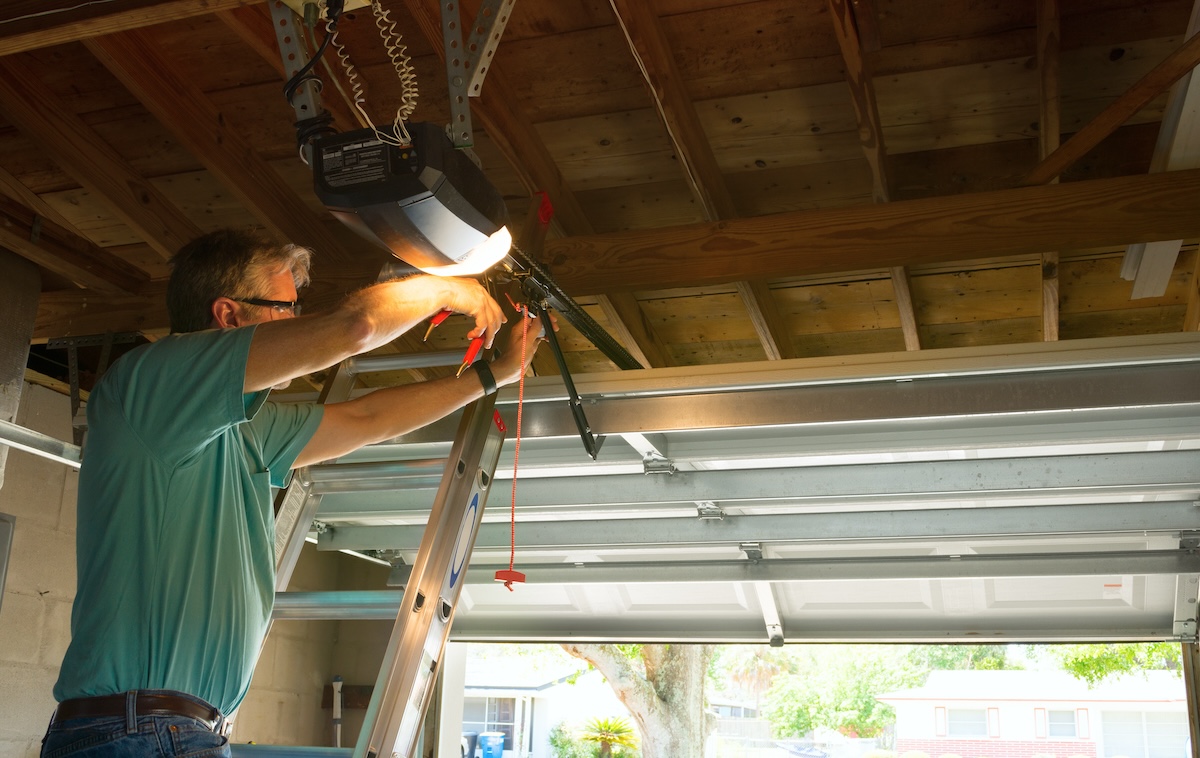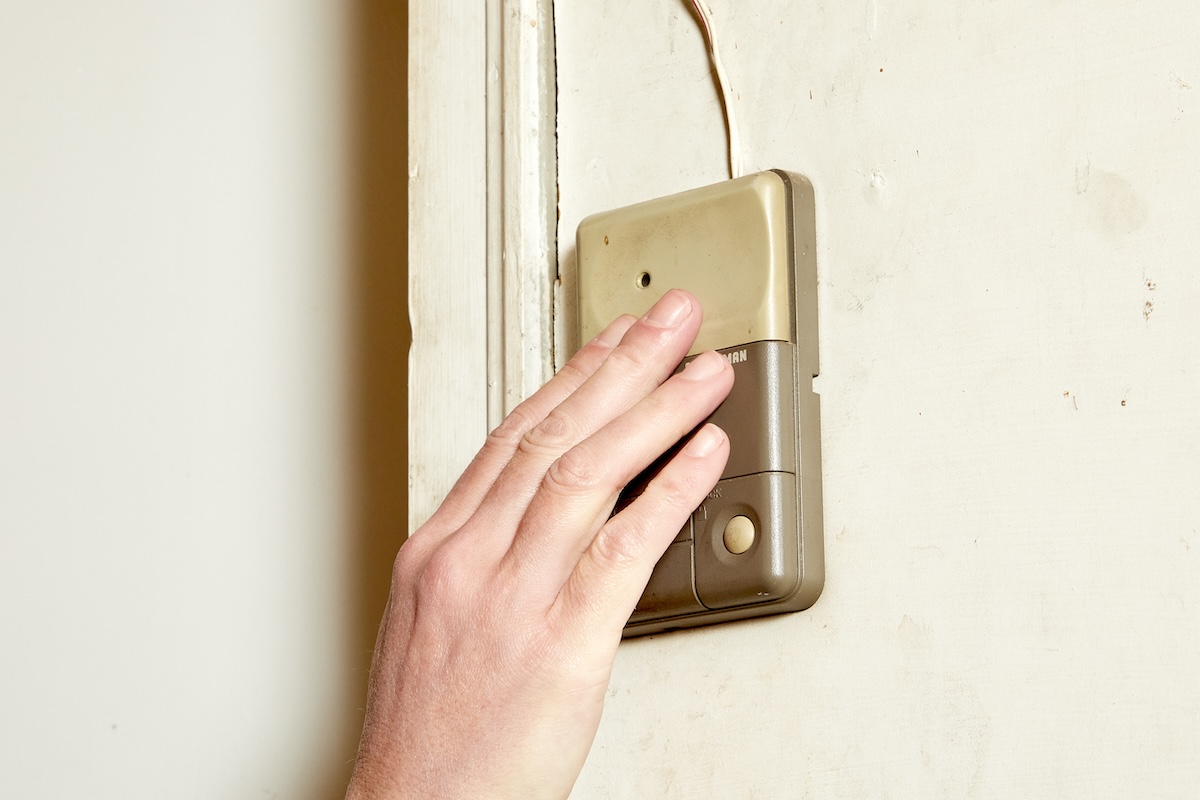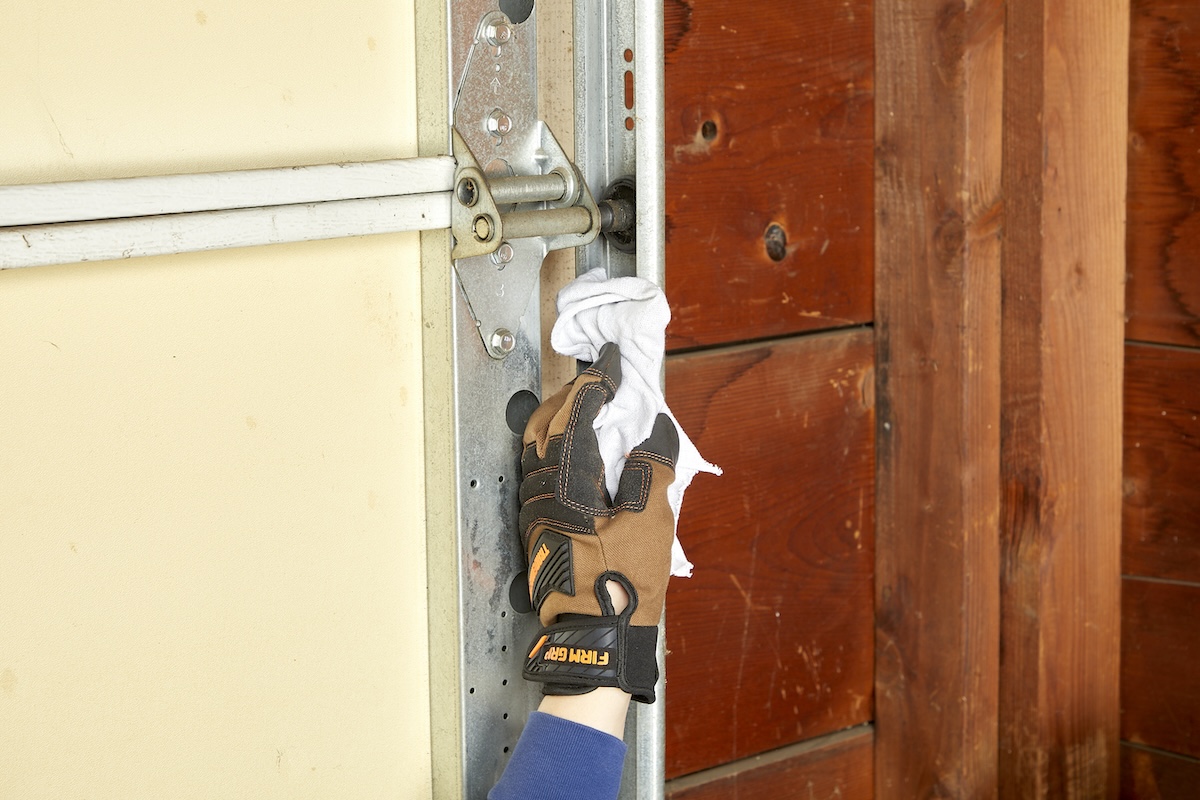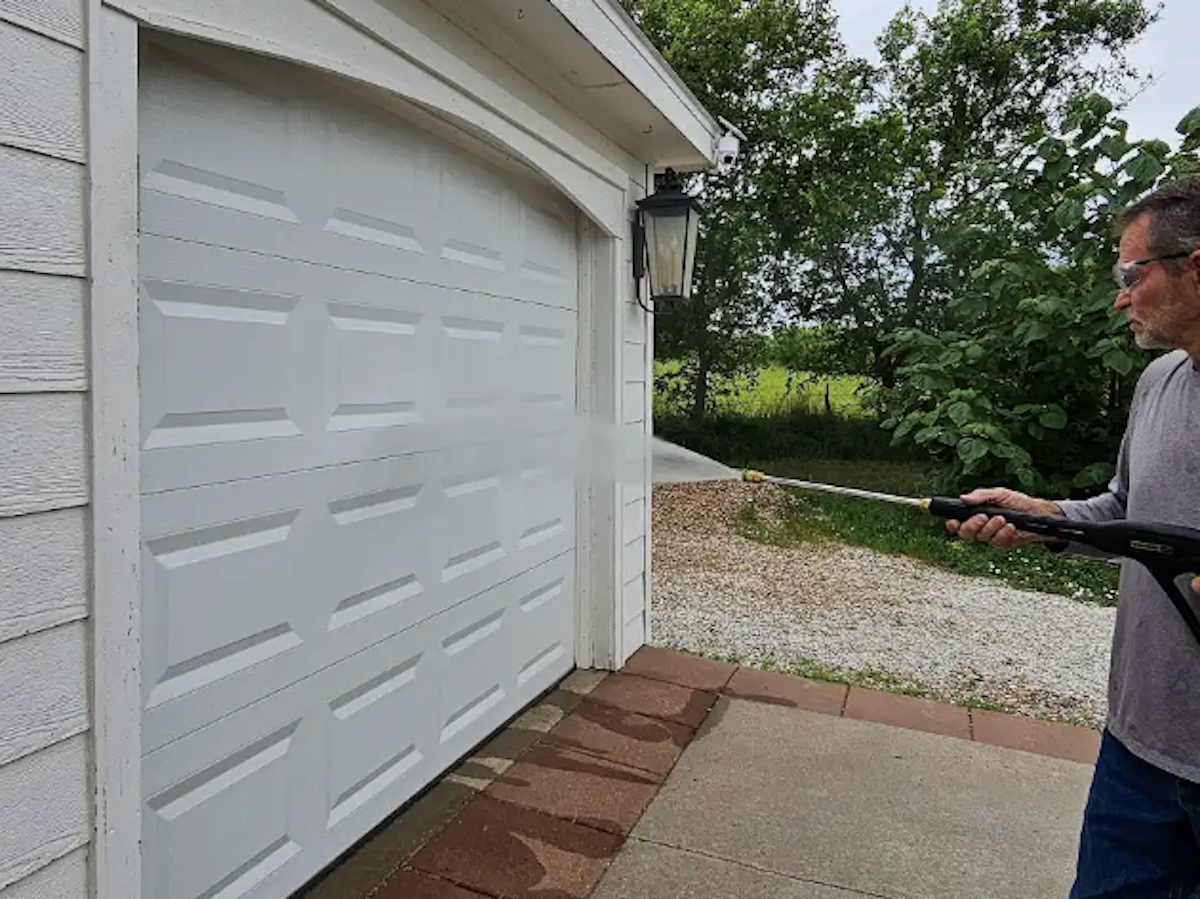

We may earn revenue from the products available on this page and participate in affiliate programs. Learn More ›
Your garage door is one of the hardest-working systems in your home, opening and closing hundreds of times each year to keep your space secure and accessible. Like any other mechanical system, it needs regular attention to stay in good shape. Without it, the constant motion can wear down rollers, springs, and hinges—leading to squeaks, strain, or even costly breakdowns over time.
To learn how to keep things running smoothly, we spoke with two garage door experts: Cassie Pound, co-owner of Stellar Garage Doors in Glenpool, Oklahoma, and Randy Oliver, president of Hollywood-Crawford Garage Door Co. in San Antonio, Texas. They shared simple upkeep steps that any homeowner can do to keep a garage door quiet, balanced, and working like new.
Why Garage Door Upkeep Is Important
Your garage door does a lot of heavy lifting—literally. It’s one of the largest moving parts in your home, and with daily use, it’s bound to show wear over time. Ignoring small issues, like squeaky rollers or uneven movement, can lead to bigger, costlier problems down the road (garage door replacement can cost as much as $6,000). Springs can snap, cables can fray, and openers can strain or fail completely if the system isn’t kept in check.
“Routine maintenance keeps all the moving parts working smoothly and helps catch issues before you have a failure on your hands,” says Pound. Oliver adds that neglecting small fixes can snowball into much larger repairs: “Even one part out of place can cause a chain reaction of wear and tear on other parts.” Staying proactive with maintenance not only keeps the door operating safely and quietly but can also add years to its lifespan.
Garage Door Maintenance Tips
1. Observe how your garage door operates.

Before diving into any maintenance for garage door tasks, start by simply watching and listening to your garage door in action. Stand inside your garage, open and close the door, and pay attention to how it moves and sounds. It should operate smoothly and quietly, without jerking, grinding, or scraping noises. A door that shakes or makes new sounds may be unbalanced or have worn rollers, hinges, or bearings.
“Anything new is a strong tell that something’s off,” says Pound, who recommends scheduling an inspection if the movement looks uneven or noisy. Catching these small red flags early can prevent larger repairs later on.
2. Test your garage door’s balance.
An unbalanced garage door can put extra strain on the opener and lead to uneven wear on springs and cables.
To check the balance: close the door and pull the red release handle to disconnect the opener. Lift the door halfway by hand—it should stay in place. If it falls or rises on its own, the springs may be worn or improperly tensioned. “A balanced door will stay put when you lift it halfway,” explains Pound, who cautions that spring adjustments are best left to professionals due to the high tension involved.
3. Assess the auto-reverse feature.
Your garage door’s auto-reverse function is a critical safety feature that stops the door from closing if something’s in the way.
To test it: place a solid object like a 2×4 or a brick under the open door, then press the close button. The door should immediately reverse once it makes contact. If it doesn’t, stop using the door until it’s serviced. “The door should rise as soon as it touches the object,” says Oliver. “If it keeps closing, that’s a clear sign something’s wrong and it’s time to call a professional.”
4. Test the door’s photo sensors.

Photo sensors help prevent accidents by stopping the garage door if something crosses its path while it’s closing.
To test them: Start closing the door and wave a long object, like a broom handle, through the beam between the sensors (these are usually low, near the floor). The door should immediately stop and reverse direction. If it doesn’t respond, wipe the lenses with a soft cloth (dust or spiderwebs can interfere with the signal). “If cleaning doesn’t fix it, stop using the door and have a professional take a look,” advises Pound, noting that malfunctioning sensors can be a major safety risk.
5. Change light bulbs and batteries regularly.
A burnt-out light bulb or weak remote battery might seem like a minor issue, but both can leave you stuck outside your garage at the worst time. Replace the bulbs in your garage door opener once a year (the LED ones work best, but check your opener’s manual for compatibility). Remote and keypad batteries usually last about a year as well.
Easy reminder: Swap them out every time you change your smoke detector batteries. Oliver recommends testing your remotes a few times a year: “A quick press can tell you if it’s time for a new battery before it fails completely.”
6. Check and tighten hardware.

Your garage door is probably moving thousands of times each year, and all that motion can loosen bolts, screws, and hinges over time. Grab a wrench or screwdriver and tighten any hardware that looks loose, especially the hinges and brackets along the track. While you’re there, inspect the rollers and hinges for signs of wear and add a small amount of silicone or lithium-based lubricant to the pivot points if needed (typically once every six months).
Next, take a look at the metal tracks. Wipe them clean with a damp cloth to remove dust and debris, but don’t lubricate them—Pound notes that grease or oil can actually attract grime and make the rollers stick.
7. Inspect the belt or chain drive.
The belt or chain that powers your garage door opener needs to stay properly tensioned to work smoothly. A loose or sagging drive can cause jerky movement and put stress on the motor. With the opener unplugged, look over the belt or chain for visible wear or slack. If it’s too loose, most openers have an adjustment bolt on the trolley assembly that allows you to tighten it slightly—just enough to remove the sag without over-tensioning.
If the chain or belt looks frayed, cracked, or rusty, it’s best to call a technician for replacement. “If the drive starts getting noisy or sluggish, check the tension or have it adjusted,” recommends Pound, who notes that a quick tune-up can often restore smooth operation.
8. Clean the door’s weather seal and replace it, if need be.
The rubber weather seal along the bottom of your garage door keeps out water, dirt, and pests while helping to insulate the space. Over time, it can crack, flatten, or pull loose, letting in drafts and moisture. Wipe the seal a few times a year with mild soap and water, then apply a silicone protectant to keep it flexible.
If it’s brittle or torn, it’s an easy DIY replacement—most home improvement stores sell pre-cut weatherstripping that slides or snaps into a channel on the bottom of the door. Pound recommends checking it twice a year, especially before major temperature changes: “A worn seal can let in water and cold air, so it’s worth keeping an eye on.”
9. Clean the garage door’s exterior.

You might clean your garage door to help with curb appeal, but it also helps protect the surface from rust, fading, and corrosion. Dirt and grime can build up around hinges and panels, causing premature wear, especially on metal or painted doors. Try to clean the exterior twice a year; spring and fall are ideal times, since you’re probably doing some outdoor cleanup then anyway.
To clean your garage door:
- Mix a mild detergent with warm water in a bucket.
- Use a soft cloth or sponge to gently wash panels from top to bottom.
- Rinse thoroughly with a garden hose. Don’t use a pressure washer, which can damage seals or paint.
- Dry with a microfiber cloth to prevent streaks.
- For metal doors, apply a coat of car wax for added protection against the elements.
If you have a pressure washer, you can also use it (using a low-pressure nozzle) to clean most garage doors. While you’re cleaning the door, Pound also suggests wiping down weather seals and trim to keep them supple and watertight.
10. Call a professional if you suspect a problem with the door’s springs.
Safety first: Garage door springs are under extreme tension and can cause serious injury if handled incorrectly. Never attempt to repair or replace garage door springs yourself.
Garage door springs do the heavy lifting, counterbalancing the door’s weight so it opens and closes smoothly. Over time, they can stretch, rust, or weaken, throwing the door off balance or making it harder to lift. “Torsion springs hold so much potential energy that you could legitimately end up in the hospital if one snaps,” warns Oliver.
To safely check for issues, pull the red release cord to disconnect the opener and lift the door halfway by hand. If it falls or feels unusually heavy, the springs may be worn out. If you suspect a problem, contact a trained technician right away. For more guidance on what to expect, see our guide to garage door spring replacement costs.
FAQ
Give your garage door a quick once-over every month. Listen for odd noises, check hardware, and make sure it’s moving smoothly. Most pros, including Pound, recommend a full professional garage door tune-up once a year, or twice a year if your door gets heavy daily use.
Lubricate all moving metal parts—like hinges, rollers, springs, and the opener chain—every six months. A light coat of silicone or lithium-based grease keeps everything running quietly and prevents wear. Avoid over-lubricating, which can attract dirt.
Not the standard kind. Regular WD-40 is actually a solvent, not a lubricant—it can dry out components and wash away protective grease. Instead, use a garage-door-safe product such as WD-40 Specialist White Lithium Grease, which provides long-lasting lubrication without attracting grime.
Yes, absolutely, garage door and garage door opener maintenance is very important. The opener should be checked every year to make sure the chain or belt tension is correct, the sensors are aligned, and the safety reverse feature is working. Oliver recommends tightening mounting brackets and cleaning the sensor lenses a few times a year to keep it running smoothly.
A professional tune-up typically costs between $150 and $350, depending on your door type, location, and whether any small parts (like rollers or cables) need replacement. Annual servicing helps prevent far more expensive repairs down the line, making it well worth the investment.
